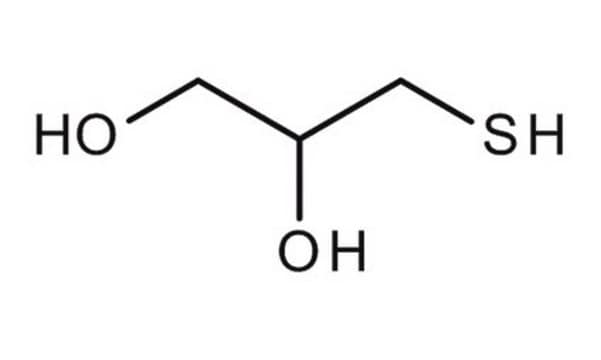Transportation information can be found in Section 14 of the product's (M)SDS.To access the shipping information for this material, use the link on the product detail page for the product.
88640
1-tioglicerol
≥99.0% (GC)
Sinónimos:
α-Monotioglicerol, α-Tioglicerol, 3-Mercapto-1,2-propanodiol
Seleccione un Tamaño
Seleccione un Tamaño
About This Item
Productos recomendados
Nivel de calidad
Ensayo
≥99.0% (GC)
Formulario
liquid
índice de refracción
n20/D 1.527 (lit.)
n20/D 1.528
bp
118 °C/5 mmHg (lit.)
densidad
1.25 g/mL at 25 °C (lit.)
cadena SMILES
OCC(O)CS
InChI
1S/C3H8O2S/c4-1-3(5)2-6/h3-6H,1-2H2
Clave InChI
PJUIMOJAAPLTRJ-UHFFFAOYSA-N
¿Está buscando productos similares? Visita Guía de comparación de productos
Aplicación
Nota de preparación
Palabra de señalización
Danger
Frases de peligro
Consejos de prudencia
Clasificaciones de peligro
Acute Tox. 3 Dermal - Acute Tox. 3 Inhalation - Acute Tox. 4 Oral - Skin Irrit. 2 - Skin Sens. 1B
Código de clase de almacenamiento
6.1C - Combustible acute toxic Cat.3 / toxic compounds or compounds which causing chronic effects
Clase de riesgo para el agua (WGK)
WGK 3
Punto de inflamabilidad (°F)
210.2 °F - closed cup
Punto de inflamabilidad (°C)
99 °C - closed cup
Equipo de protección personal
Eyeshields, Faceshields, Gloves, type ABEK (EN14387) respirator filter
Elija entre una de las versiones más recientes:
¿Ya tiene este producto?
Encuentre la documentación para los productos que ha comprado recientemente en la Biblioteca de documentos.
Los clientes también vieron
-
What is the Department of Transportation shipping information for this product?
1 answer-
Helpful?
-
-
How does the storage temperature relate to shipping conditions?
1 answer-
The storage conditions that a Sigma-Aldrich catalog and label recommend for products are deliberately conservative. For many products, long-term storage at low temperatures will increase the time during which they are expected to remain in specification and therefore are labeled accordingly. Where short-term storage, shipping time frame, or exposure to conditions other than those recommended for long-term storage will not affect product quality, Sigma-Aldrich will ship at ambient temperature. The products sensitive to short-term exposure to conditions other than their recommended long-term storage are shipped on wet or dry ice. Ambient temperature shipping helps to control shipping costs for our customers. At any time, our customers can request wet- or dry-ice shipment, but the special handling is at customer expense if our product history indicates that the product is stable for regular shipment.
Helpful?
-
-
What is the concentration of the 1-thioglycerol?
1 answer-
The liquid is not a solution of 1-thioglycerol in some solvent. Rather, it is a neat liquid (i.e., essentially pure 1-thioglycerol). Based on a density of 1.245 g/mL and a molecular weight of 108.2 g/mole, one can calculate an effective molarity of 11.5 M. This information may be found on the M1753 product information sheet.
Helpful?
-
Active Filters
Nuestro equipo de científicos tiene experiencia en todas las áreas de investigación: Ciencias de la vida, Ciencia de los materiales, Síntesis química, Cromatografía, Analítica y muchas otras.
Póngase en contacto con el Servicio técnico










